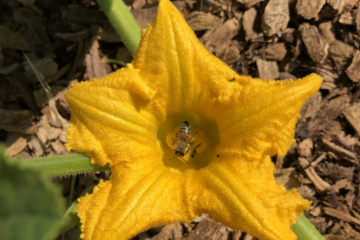Written by Nathalie Grogan, Grant Writing and Development
The social and ecological effects of food production have been highlighted within recent years as a direct contributor to ongoing crises of climate change, food insecurity, obesity and toxic health effects (“Food”). In fact, Forbes reported in March that more than a third of all man-made greenhouse gas emissions are generated by food systems (Vetter). Simultaneously, Feeding America reports that in 2021, 42 million people in the US may experience food insecurity due to overlapping, systemic issues of access, affordability and sustainability, which is directly linked to the way that the food system functions (“How”).
There’s that phrase again, food systems. While the concept of food systems are directly related to discussions of food production, access and the environment, it is a phrase that is often tossed around with little context. To understand how and why sustainable gardens are so important, and how growing your own food, contributing to a community garden, or supporting gardening efforts is of critical importance, you must first understand what food systems are.
The term “food systems” refers to the worldwide adoption of a systems understanding of food production and consumption. According to the United Nations, “The food system includes the related resources, the inputs, production, transport, processing and manufacturing industries, retailing, and consumption of food as well as its impacts on environment, health, and society” (“Food”). Therefore, the concept of food systems is a way of conceptualizing food production as an interrelated web of systemic functions with inherent feedback loops and chain-reactions. Traditionally, components of a production system have been assessed in isolation, with the assumption that improving a single component will improve the entire production system (“What is the food system?”). A food systems approach recognizes that there are systems within systems which have feedback and complex interactions, which necessitates a holistic approach.
With this understanding in mind, let’s delve into how scientists have used the concept of food systems to assess the causes and solutions to some of the largest environmental and health related issues people experience in the world today.
According to Feedback, a campaign group working to regenerate nature by transforming the food system, a primary reason that our food system is unsustainable, massively pollutive, and inefficient at equally distributing nutritious food is that our system is linear, not circular. Our food system moves in one direction, from production to disposal, and the waste that is disposed of is not reused or recycled. By looking at food production as a system, this linear pattern can be discerned, and the processes for turning a linear system into a circular (or at least partly circular) system can be discovered (“Our Model”). Feedback explains that when it comes to food, “if food is still fit for human consumption, it should feed people. If not, it should be repurposed to feed livestock and fish, and finally, fed to soils through compost and manure. All three levels of the food system – humans, animals and soils – need to be fed and replenished to create a sustainable future” (“Our Model”). According to Feeding America, every year approximately 108 billion pounds of food is wasted in the US, which equates to more than 161 billion dollars of food waste each year (“How”). Food waste is only one of the numerous problems that the environment and people experience in direct correlation to an ineffective and unsustainable food system.
Understanding what the food systems are, and the importance of a food systems approach, affords important perspective to everyone who hopes to fight against climate change, food insecurity, and unethical production practices, as consumption and production patterns must be brought together and assessed holistically, not as individual components (“Food”).
Gardens can be recognized as their own, small scale food systems, with production and consumption compressed, and with many opportunities for sustainability, accessibility and compassion. Home gardens and community gardens allow people to create their own food systems that are ethical and sustainable, adopting a circular pattern which re-uses resources, instead of wasting them. And while there is much work to be done to redesign our food systems, starting at home, and within communities, can have a huge impact.
Resources:
“Food Systems — Definition, Concept and Application for the UN Food Systems Summit”. United Nations Food Systems Summit 2021, Scientific Group. (2021).https://www.un.org/sites/un2.un.org/files/food_systems_concept_paper_scientific_group_-_draft_oct_26.pdf
“How do you measure hunger?” Feeding America. (2021). https://www.feedingamerica.org/hunger-in-america/food-insecurity.
“Our model.” Feedback. (2020, September 11). https://feedbackglobal.org/building-better-food-system/.
Vetter, D. (2021, March 10). How Much Does Our Food Contribute To Global Warming? New Research Reveals All. Forbes. https://www.forbes.com/sites/davidrvetter/2021/03/10/how-much-does-our-food-contribute-to-global-warming-new-research-reveals-all/?sh=336e5edc27d7.“WHAT IS THE FOOD SYSTEM?” Future of Food. (n.d.). https://www.futureoffood.ox.ac.uk/what-food-system.



0 Comments